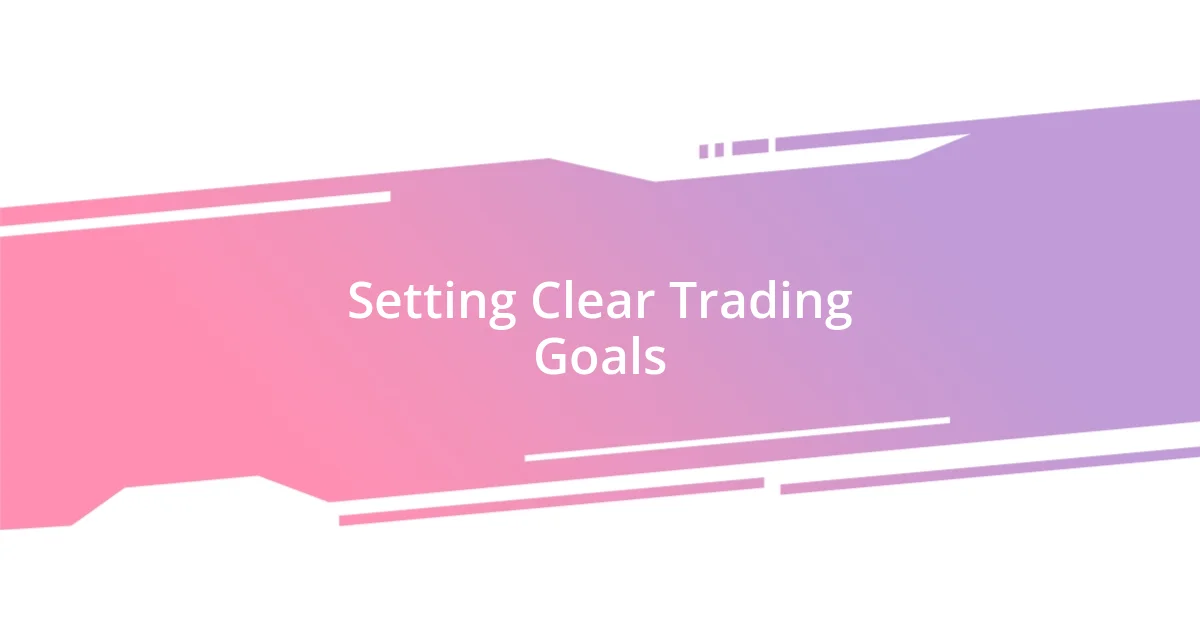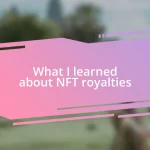Key takeaways:
- Understanding blockchain technology and market trends is essential for successful NFT trading.
- Diversifying the NFT portfolio across various genres and platforms mitigates risks and opens up new opportunities.
- Setting clear trading goals and managing risks through disciplined budgeting enhances the overall trading experience and decision-making process.

Understanding NFT Trading Basics
NFT trading is fascinating because it combines art, technology, and a bit of speculation. When I first dipped my toes into this space, I remember feeling a rush of excitement as I explored different marketplaces. How could a digital item hold value? It’s a question that perplexed many, yet the vibrant community and unique items swiftly drew me in.
In the realm of NFTs, understanding blockchain technology is crucial, as it underpins the authenticity and ownership of these digital assets. When I first learned about how blockchain works, I felt like I’d stumbled upon a secret club; it transformed my perspective on digital ownership. Don’t you think it’s empowering to own something that is verified and unique, especially in a digital world where replication is the norm?
Trading NFTs isn’t just about buying and selling; it involves a certain level of strategy and an understanding of market trends. I often find myself analyzing how specific artists or trends can impact the value of their works. Have you ever considered what makes an NFT desirable? For me, it often comes down to a mix of emotional connection and artistic value. This awareness has guided my buying choices, leading me to more fulfilling trades.

Identifying Profitable NFTs
Identifying profitable NFTs can sometimes feel like searching for hidden treasures in a vast digital ocean. I recall one instance when I stumbled upon a lesser-known artist who was just starting to gain traction on Twitter. Their unique style resonated with me, and I made a small investment. A few weeks later, as their community grew, I watched as the value of my NFT soared. It’s those moments of discovery that keep the thrill alive in NFT trading.
Notably, trending themes and cultural events often influence the demand for certain NFTs. For example, I actively follow pop culture, and when a popular TV series features a particular artist’s work, it often leads to a spike in interest. Having a finger on the pulse of what’s current can give you an edge. I once sold an NFT shortly after a celebrity mentioned it, and the profit was quite rewarding.
I’ve also found that examining the creator’s social media presence offers insights into potential profitability. A strong, engaged community can elevate the value of an NFT. Just last month, I invested in a digital collectible because the creator had an enthusiastic following. I’ve seen firsthand how that connection can drive prices up, elevating both the artist and early investors alike.
| Criteria | Insights |
|---|---|
| Community Engagement | Follow creators with active, enthusiastic followers. |
| Market Trends | Stay updated on pop culture influences. |

Diversifying Your NFT Portfolio
When I started my NFT journey, I quickly realized that putting all my eggs in one basket could be detrimental. Diversifying my portfolio has not only helped mitigate risks but also allowed me to explore various niches in the vibrant NFT landscape. For instance, I invested in digital art, music, and even virtual real estate, observing how each of these areas responded to market dynamics. It felt thrilling to watch my investment variety thrive, reminding me that the NFT space is as diverse as the creators behind it.
Here are some key components to consider when diversifying your NFT portfolio:
- Art vs. Collectibles: Balance investments in digital art with collectible items to tap into different audience interests.
- Emerging Artists: Explore works from up-and-coming creators who may have untapped potential, as their value can grow significantly over time.
- Different Platforms: Engage with multiple NFT marketplaces so you can access varied offerings and price points.
- Utility NFTs: Look into NFTs that offer real-world benefits, such as access to exclusive content or events, providing additional value.
- Community Focus: Invest in projects with strong communities, as these often have greater likelihood for growth and sustained interest.
By embracing diversification, I’ve been able to navigate the ups and downs of the NFT market with more confidence. Each unique asset brings its own story and potential, making the journey all the more enriching.

Setting Clear Trading Goals
Setting clear trading goals is essential in the fast-paced NFT market. When I first delved into NFT trading, I vividly remember the excitement of buying my first piece but then quickly feeling overwhelmed. It dawned on me that without specific goals, I was just riding a wave without a surfboard. Establishing clear targets—like setting a percentage profit I wanted to achieve or defining a timeframe for holding NFTs—helped ground me in this chaotic environment.
I often ask myself, “What do I want to achieve in the next month?” This question keeps me focused and drives my decisions. For instance, when I planned a goal to acquire a certain number of unique pieces each month, I discovered not just variety but also a deeper appreciation for each NFT’s story and the artist behind it. Goals not only streamline my approach but enhance my emotional investment in each transaction.
Moreover, periodically revisiting these goals is crucial. I initially set a long-term target to build a collection worth a specific amount. However, as the market evolved, I learned to adjust these goals, making them more feasible or ambitious based on market conditions. Each adjustment taught me resilience; my goals felt like a personal compass, guiding me through various trading storms. How about you? Have you found that setting clear goals transforms your trading experience too?

Analyzing Market Trends Effectively
Analyzing market trends effectively is like deciphering a complex puzzle, and I’ve found it to be a crucial skill. Early in my trading days, I often made impulsive decisions based on fleeting emotions rather than solid data. By honing my ability to track trends—like monitoring volume changes or observing buyer behaviors—I discovered that patterns often repeat themselves in the NFT space. Isn’t it fascinating how historical data can illuminate potential future movements?
I once spent an evening poring over charts from my favorite NFT artists, and it struck me how certain drops consistently spiked in value after particular events, like collaborations or social media buzz. This process taught me to anticipate rather than react; I began to position myself strategically instead of simply following the hype. When I picked up on the growing trend of utility NFTs offering more than just digital art—like exclusive event access—I felt empowered to make informed choices. Have you noticed how these insights can open up entirely new avenues for investment opportunities?
Staying informed about broader market narratives is equally essential. I often immerse myself in online communities and leading industry discussions, which provide timely insights into potential shifts. Recently, I recall reading about increasing institutional interest in NFTs and recognizing its implications for long-term growth. This knowledge shift makes me approach my trades with a keen sense of purpose and an eye for potential. How do you stay updated with the ebb and flow of NFT trends? Pinpointing these dynamics has not only enhanced my trading strategy but also deepened my engagement with the entire NFT ecosystem.

Utilizing NFT Marketplaces Strategically
Utilizing NFT marketplaces strategically has been a game changer for me. When I first started trading, I visited every marketplace available, which felt like wandering through a maze. Then it hit me—focusing on a few key platforms like OpenSea and Rarible helped streamline my activities, allowing me to specialize in what each has to offer. I learned that each marketplace has its unique audience and themes, and this focus has not only made me more efficient but also more confident in my selections.
I remember the excitement of a recent drop on a less-known marketplace that specialized in gaming NFTs. Most traders overlooked it, but I recognized the potential. By engaging with the community there, I not only secured valuable pieces but also forged connections with like-minded individuals. These relationships have enriched my trading experience, providing insights and tips that often go unnoticed in larger marketplaces. Don’t you think that getting involved on a personal level can yield unexpected opportunities?
Moreover, I’ve found that timing my transactions within marketplaces can significantly impact profitability. For instance, I’ve observed the best prices often emerge during off-peak hours, catching great deals while others sleep. This strategy requires vigilance, but to me, it feels rewarding. Mastering the rhythm of when to buy or sell based on activity levels makes me feel like I am truly in control of my trading destiny. How have you leveraged the dynamics of different marketplaces in your own trading journey?

Managing Risks in NFT Trading
Managing risks in NFT trading has become my mantra, especially after experiencing the unpredictable nature of this market firsthand. One day, I found myself swept up in a bidding war for an NFT that everyone was excited about. I jumped in without fully understanding the underlying value, only to watch my investment plummet the next week. This taught me an invaluable lesson: assessing the long-term viability of a project is as crucial as the initial allure.
I also prioritize diversification in my NFT portfolio, which has helped cushion the blows during market fluctuations. Instead of putting all my resources into a single type of NFT—like digital art—I spread my investments across different genres, including music and virtual real estate. This approach not only minimizes risk but opens doors to new opportunities. Have you considered how diversifying your assets could lead to unexpected gains in this volatile market?
Setting strict budgets for each trade is another technique I swear by. I recall a period where I was tempted to overspend on high-profile pieces, thinking they would skyrocket in value. By sticking to a defined budget, I learned to be a more disciplined trader, allowing me to make smarter choices without the emotional rollercoaster that comes with impulsive buying. How do you manage your capital when the excitement of NFT trading is in the air? Finding the sweet spot between passion and prudence is what truly empowers me in my trading journey.














